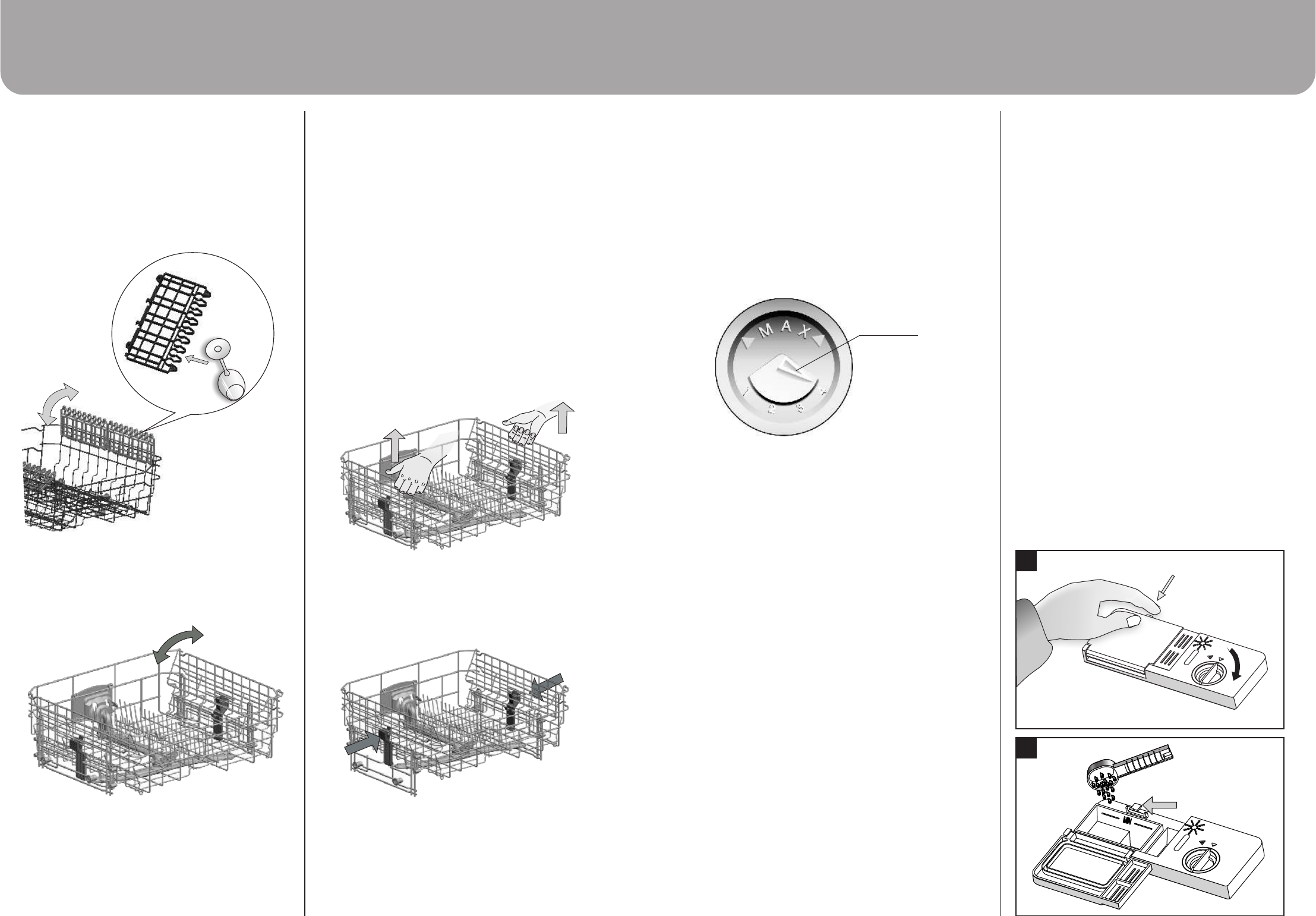
Using Your Dishwasher
Page 15Page 18
Using Your Dishwasher
Adjusting the Rinse Aid Dispenser
The rinse aid dispenser has four scales. Always start
with the dispenser set on "3". If spots and poor drying
are a problem, increase the amount of rinse aid
dispensed by removing the dispenser lid and rotating
the dial to "4". The recommended setting is "3".
(Factory value is "3".)
NOTE: Increase the dose if there are drops of water or
lime spots on the dishes after washing. Reduce it if
there are sticky whitish stains on your dishes or a
bluish film on glassware or knife blades.
The upper basket height is adjustable. There is a
higher and lower position for the upper basket which
is used to wash dishes with different heights. You can
lift the basket or press the adjustor to the upper and
lower position.
Long items, serving cutlery, salad servers or knives
should be placed on the shelf so that they do not
obstruct the rotation of the spray arms. The shelf can
be rotated and lifted according to dishes. When not
required, the shelf can be folded back at the lower
height.
To adjust the height, grip the shelf on the side edges
and lift it to the higher position, then rotate to the
desired position.
Adjust lever
(Rinse)
A
Pr
ess
Pr
ess
Position 1: Lower Position
Pull up the left and right steel wire to raise up the
upper basket to position 2.
Position 2: Higher Position
Press the left and right adjustors to lower the upper
basket to position 1.
Detergents
There are 3 sorts of detergents:
1. With phosphate and with chlorine
2. With phosphate and without chlorine
3. Without phosphate and without chlorine
Normally new pulverised detergent is without
phosphate. Thus the water softener function of
phosphate is not given. In this case we recommend to
fill salt in the salt container even when the hardness of
water is only 6 °dH. If detergents without phosphate
are used in the case of hard water often white spots
appear on dishes and glasses. In this case please add
more detergent to reach better results. Detergents
without chlorine do only bleach a little. Strong and
coloured spots will not be removed completely. In this
case please choose a program with a higher
temperature.
Concentrated Detergent
Based on their chemical composition, detergents can
be split in two basic types:
Conventional, alkaline detergents with caustic
Ÿ
components
Low alkaline concentrated detergents with natural
Ÿ
enzymes
The use of“normal” washing programs in combination
with concentrated detergents reduces pollution and is
good for your dishes; these wash programs are
specifically matched to the dirt-dissolving properties
of the enzymes of the concentrated detergent. For this
reason “normal”wash programs in which
concentrated detergents are used can achieve the
same results that can otherwise only be achieved
using “intensive” programs.
Detergent Tablets
Detergent tablets of different brands dissolve at
different speeds. For this reason some detergent
tablets cannot dissolve and develop their full cleaning
power during short programs. Therefore please use
long programs when using detergent tablets, to
ensure the complete removal of detergent residuals.
Detergent Dispenser
The dispenser must be refilled before the start of each
wash cycle following the instructions provided in the
wash cycle table. Your dishwasher uses less
detergent and rinse aid than Conventional
dishwasher. Generally, only one tablespoon of
detergent is needed for a normal wash load. More
heavily soiled items need more detergent. Always add
the detergent just before starting the dishwasher,
otherwise it could get damp and will not dissolve
properly.
Adding detergent to Dishwasher
If the lid is closed: press release button. The lid will
Ÿ
spring open.
Always add the detergent just before starting each
Ÿ
wash cycle.
Only use branded detergent aid for dishwasher.
Ÿ
Push latch to open
1
2
Adjusting the Upper Basket
The upper rack is for more delicate and lighter
dishware such as glasses, coffee & tea cups, saucers,
plates, bowls, and shallow pans (provided these are
not too dirty).
Position the dishes and cookware so that they do not
get moved by the spray of water. Always place
glasses, cups & bowls upside down.
A
Shelf ‘A’
Shelf ‘A’ can be hung up on the sides or layed down on
the bottom of the upper basket
In
Shelf


















